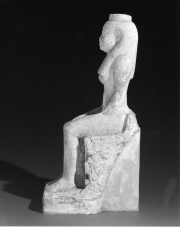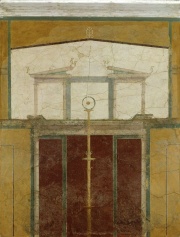Difference between revisions of "Plaster"
(username removed) |
|||
| (3 intermediate revisions by 2 users not shown) | |||
| Line 1: | Line 1: | ||
| − | [[File:00.708-C34542.jpg|thumb|]] | + | [[File:00.708-C34542.jpg|thumb|Statuette of Isis<br>MFA# 00.708]] |
== Description == | == Description == | ||
| + | [[File:33.499-E14382CR-d1.jpg|thumb|Fresco Panel<br>MFA # 33.499]] | ||
| + | 1) Shortened name for [[plaster%20of%20Paris|plaster of Paris]] which is composed of calcium sulfate hemihydrate. It is also called calcined gypsum. | ||
| − | + | 2) A powder, that forms a pasty mixture with water and dries to a hard impenetrable solid. Clays plasters were used in Egypt since at least 2000 BCE for coating walls and ceilings. Decorative wall paintings with plaster supports were made in Crete as early the 15th century BCE. Plaster is made using several formulations. Most plasters contains calcined [[gypsum|gypsum]] or [[lime|lime]] as a binder. Many use [[sand|sand]], [[hair|hair]], [[hair|hair]]hair, or [[straw|straw]] as extenders. Some may contain small amounts of salts ([[potassium%20sulfate|potassium sulfate]]) as accelerants. Organic materials ([[blood|blood]], [[glue|glue]], [[casein|casein]]) and weak acids ([[citric%20acid|citric acid]], [[boric%20acid|boric acid]]) can act as retardants. Plaster is still used as a finish material in wall and ceiling construction. Some examples of plaster types are: | |
| − | + | * [[lime%20plaster|lime plaster]] - contains calcium oxide; used for frescos and wall decoration | |
| + | * [[gypsum%20plaster|gypsum plaster]] - contains calcined and ground gypsum; See also [[gypsum%20cement|gypsum cement]]. | ||
| + | * [[plaster%20of%20Paris|plaster of Paris]] - calcined gypsum; used for molds, sculpture, casts | ||
| + | * [[stucco|stucco]] - contains gypsum and sand or chalk; used for walls, ceilings, decoration | ||
| − | |||
| − | |||
| − | |||
| − | |||
| − | |||
| − | |||
| − | |||
| − | |||
| − | |||
== Synonyms and Related Terms == | == Synonyms and Related Terms == | ||
plâtre (Fr.); estuque (Port.); | plâtre (Fr.); estuque (Port.); | ||
| − | == | + | == Resources and Citations == |
* R. J. Gettens, G.L. Stout, ''Painting Materials, A Short Encyclopaedia'', Dover Publications, New York, 1966 | * R. J. Gettens, G.L. Stout, ''Painting Materials, A Short Encyclopaedia'', Dover Publications, New York, 1966 | ||
| Line 29: | Line 25: | ||
* ''Dictionary of Building Preservation'', Ward Bucher, ed., John Wiley & Sons, Inc., New York City, 1996 | * ''Dictionary of Building Preservation'', Ward Bucher, ed., John Wiley & Sons, Inc., New York City, 1996 | ||
| − | * ''Encyclopedia Britannica'', http://www.britannica.com Comment: "plaster" | + | * ''Encyclopedia Britannica'', http://www.britannica.com Comment: "plaster" [Accessed October 31, 2001]. |
| − | * Art and Architecture Thesaurus Online, | + | * Art and Architecture Thesaurus Online, https://www.getty.edu/research/tools/vocabulary/aat/, J. Paul Getty Trust, Los Angeles, 2000 |
[[Category:Materials database]] | [[Category:Materials database]] | ||
Latest revision as of 14:09, 17 August 2022
Description
1) Shortened name for Plaster of Paris which is composed of calcium sulfate hemihydrate. It is also called calcined gypsum.
2) A powder, that forms a pasty mixture with water and dries to a hard impenetrable solid. Clays plasters were used in Egypt since at least 2000 BCE for coating walls and ceilings. Decorative wall paintings with plaster supports were made in Crete as early the 15th century BCE. Plaster is made using several formulations. Most plasters contains calcined Gypsum or Lime as a binder. Many use Sand, Hair, hairhair, or Straw as extenders. Some may contain small amounts of salts (Potassium sulfate) as accelerants. Organic materials (Blood, Glue, Casein) and weak acids (Citric acid, Boric acid) can act as retardants. Plaster is still used as a finish material in wall and ceiling construction. Some examples of plaster types are:
- Lime plaster - contains calcium oxide; used for frescos and wall decoration
- Gypsum plaster - contains calcined and ground gypsum; See also Gypsum cement.
- Plaster of Paris - calcined gypsum; used for molds, sculpture, casts
- Stucco - contains gypsum and sand or chalk; used for walls, ceilings, decoration
Synonyms and Related Terms
plâtre (Fr.); estuque (Port.);
Resources and Citations
- R. J. Gettens, G.L. Stout, Painting Materials, A Short Encyclopaedia, Dover Publications, New York, 1966
- G.S.Brady, Materials Handbook, McGraw-Hill Book Co., New York, 1971 Comment: p. 386
- Ralph Mayer, A Dictionary of Art Terms and Techniques, Harper and Row Publishers, New York, 1969 (also 1945 printing)
- Dictionary of Building Preservation, Ward Bucher, ed., John Wiley & Sons, Inc., New York City, 1996
- Encyclopedia Britannica, http://www.britannica.com Comment: "plaster" [Accessed October 31, 2001].
- Art and Architecture Thesaurus Online, https://www.getty.edu/research/tools/vocabulary/aat/, J. Paul Getty Trust, Los Angeles, 2000

